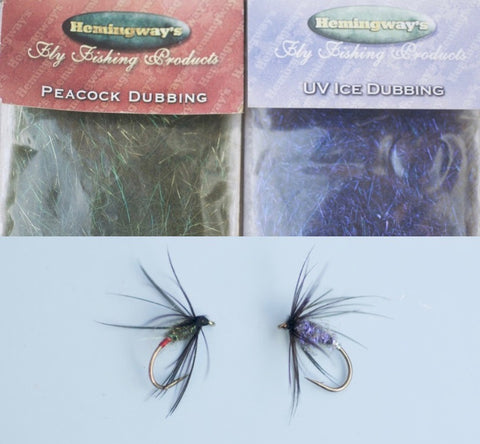FLY TYING TIPS: BEST HEMINGWAY’S MATERIALS & HOW TO USE THEM!
It’s no surprise that fly tyers of all kinds just love Hemingway’s products. They offer a touch of class to almost any fly pattern, yet are so simple to use! This month, Dom Garnett talks us through a handful of easy to tie fly patterns for trout and coarse fish using his favourite Hemingway’s ingredients.
You can find all these products and more in the Hemingway’s section of our website.
- Conehead Flash Bugger/ Hemingway’s Flashback Foil

The obvious use for this excellent product is to add a touch of extra attraction to your nymphs, such as the namesake Flashback PTN! It also makes a nice, bright shellback on grayling bugs.
However, perhaps my favourite pattern to tie with this material is a meaty lure. The pattern shown has worked a treat for fly fishing on Roadford Reservoir, in particular. Predatory brown trout love it, but so do the perch! It’s very easy to tie as well- and the critical thing is to get your body nice and even. To do this, make sure you have a steady thread base to the body, before rolling on off a decent strip of foil in gently overlapping turns.
You can also try different heads, but the cone is supremely practical to give a nice fast sink rate. I like to fish this around any drop offs close to the bank, with a lively retrieve.
Conehead Flash Bugger
Hook: Turrall Extra Long Streamer 8-10
Thread: Black
Head: Cone head (or bead head of your choice)
Tail: Black marabou/ hint of UV flash
Rib: Silver Wire
Body: Hemingway’s Flashback Foil (peacock)
- Peacock and UV Spiders / Peacock & UV Ice Dubbing

These are the simplest of flies, but superb for both wild browns or indeed coarse fish. I’ve had rudd to over 2lbs on these flies, along with plenty of quality roach and trout, while they also catch carp on weedy lakes. Regardless of species, these are deadly on the pause- so don’t be afraid just to let them hang and let the fish do the rest.
Much as I like traditional materials, I suspect that these synthetic Peacock and UV dubbings are better than actual feather herl! Modern materials have more flash for one thing- and are much easier to tie and more durable. The dark green colour is a nod to traditional peacock. The idea is something suggestive rather than match the hatch, but I think it does a good impression of a fallen beetle.

That said, a bluish UV version has also done well for me- and is just as simple to tie! Like a fine quality Pilsner, just four ingredients are needed. That said, you can also add a “butt” of Holo Flat Tinsel for added attraction. Go easy on the hen hackle for a nice sparse, mobile feel.
Black and Peacock Spider/ Black and UV Spider
Hook: Wide gape nymph or Turrall barbless grub 14-16
Thread: Black
Tag (optional) Hemingway’s holo Flat Tinsel, red or silver
Body: Peacock or UV Ice Dubbing
Hackle: Black Hen
- JC Quill buzzer / Hemningway’s Synthetic Peacock Quill

Here’s a fantastic product for anyone who finds natural quill tricky to use. This stuff is so much simpler to handle but is so perfectly coloured and even, it’s hard to tell from the real thing.
The uses are endless. Natural style river flies are one obvious role, but I especially like the material for buzzers. You get a lovely sparse, segmented effect and a beautifully simple fly. You’d catch plenty of fish on just the simplest quill body and thread for a head- but I do like to add some tiny slips of jungle cock as a target point.
Varnish well and this is also a highly durable fly. Natural is the obvious colour choice, but you can also try really outlandish colours in the range to make a stand out option- and the metallic gold colour has scored well for me.
Quill Buzzer
Hook: Buzzer or Nymph, sizes 12-14
Thread: Black
Body: Synthetic quill in chosen colour, well varnished
Head: Thread / Jungle cock slips (optional)
- Quill Dun/ Hemingway’s Mayfly Wings

Another fly tying technique that frustrates the heck out of a lot of anglers is adding paired wings to a dry fly. Not only are they fiddly, one meaty take or angry trout and they usually end up a frayed mess anyway. Thank goodness, therefore, for this dead easy to use product. No more agony over how to tie traditional dry fly wings!
All you need to do is carefully cut these wings from the sheet and tie in via the neat little tab provided. For tidiness, you can then cover any stubs with a touch of soft dubbing. There are lots of colours and sizes, too, whether you want a full sized classic Mayfly or a smaller variant. I find the smaller wings especially good for imitations of Blue Winged Olives, Pale Wateries and other common smaller mayflies.

Quill Dun
Hook: Barbless dry fly 14-16
Thread: Tan
Tail: Pheasant fibres
Wings: Hemingways Mayfly wings II, XS
Thorax: Touch of light hare’s ear
Hackle: Badger cock






Leave a comment